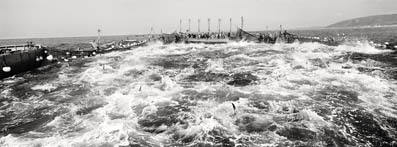
With Andalusian Arabic origin meaning ‘a place to strike’, almadraba is a fishing technique practised since time immemorial in the south of the Iberian Peninsula, the meeting point of the waters of the Atlantic Ocean and the Mediterranean Sea. An exhibition with photographies by Jaume Fuster is inaugurated today, 9 June, at 18:30 hours at the Cultural Centre La Nau, recovering this amazing battle between fishes and humans.
Through 31 impressive panoramic black and white photos, the photograph Jaume Fuster tells his journey to the most ancient fishing art of the Mediterranean. Guided by the fisherman Jacinto Vaello, it follows the route traced by the life cycle of the big tunas and it invites to get to know the same rituals, smells and sounds lived by generations and generations of almadraberos (fishermen).
The work by Fuster about the almadraba is edited inside the book ‘Almadraba’ published in 2015 by the Universitat de València, in which a set of texts completes and goes in depth into the story of the images.
At the exhibition, which will take place at the Oberta Nau of the Cultural Centre La Nau until 11 September, there will also a showing of some boat models and ancient objects related to this fishing art.
Jaume Fuster (Benidorm, 1970)
Professor of Artistic Photography at the Valencian School of Art and College of Design. He is doctor of the Department of Audiovisual Communication, Documentation and Art History at the Universitat Politècnica de València. Fuster graduated in Information Sciences, Visual and Auditory Imagery at the Universitat Politècnica de València. Between 2002 and 2006, he was productor in RTTV, at the Department of Planning and Audiovisual Development. Between 1997 and 2002, he was camera operator in RTVV, Canal 9.
Last update: 9 de june de 2016 09:10.
News release



















